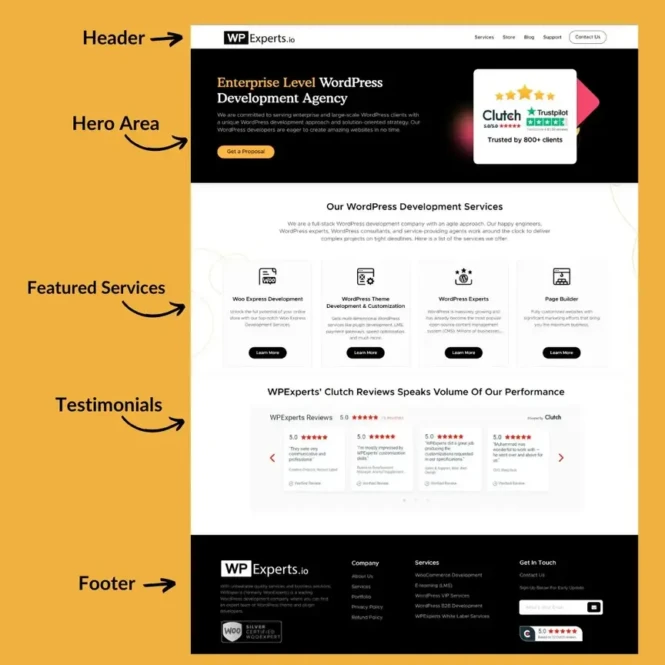Planning a website can be hard, especially when deciding what pages to include. Many people don’t know which pages are important and how many pages they need. This can make websites confusing or messy, and visitors might leave quickly.
In this blog, we’ll explain the key pages every website should have and how to choose the right number of pages. This will help you make an organized website that people will love.
Table of Contents
Essential Pages for Every Website
Every website is unique and can have different pages based on its needs, but some pages are fundamental for every website. Here are the essential pages you should include:
Home Page
The home page is where users first land when they visit your website. This is where you want to give the visitor an overview of what the website offers. Studies show that visitors typically spend 10-20 seconds on a homepage before deciding whether to stay or leave.
So, you need to pay special attention to designing the home page. While the home page design varies, the common parts of a home page are:
Header: This section typically includes a logo and links to other important pages on your website. It allows visitors to easily navigate to different sections. The header usually stays the same for the whole website.
Hero Area: The hero area is the first section of the home page that visitors see without scrolling down. It usually includes headings, images, and call-to-action (CTA) buttons. This section is crucial for capturing visitors’ attention and encouraging them to explore further.
Featured Content/Services: Showcase your most important content or services prominently on the home page. This could include featured products, popular blog posts, or key information you want to highlight.
Testimonials or Social Proof: Displaying testimonials from satisfied customers or clients can help build trust. Additionally, showcasing badges or certifications can enhance credibility.
Footer: The footer is the bottom section of the home page that typically includes additional navigation links, contact information, social media icons, and copyright details. It provides a convenient way for visitors to access important information and navigate to other parts of the website.
The design elements mentioned above are not mandatory to follow, but having a homepage is essential.

About Page
The About page is like an introduction, giving people an idea about you or your business. It helps build a connection and trust. According to KoMarketing, 52% of website visitors want to see the company’s About page when they land on the website.
You should briefly introduce yourself or your business, share your journey and beliefs, and introduce any team members.
Highlight any major achievements or awards, and consider including positive feedback from satisfied customers. Finally, ask people to do something like contact you or look around your site more. This way, people can get to know you better and feel comfortable using your website.
Contact Page
The Contact page is another core page for visitors to easily reach out to you. Including a contact number on your website can increase trust by 30%, according to KoMarketing.
It’s important to display your contact information such as email, phone number, and physical address. Additionally, consider including a user-friendly contact form for receiving messages.
If your business is active on social media, don’t forget to share those profiles. If applicable, provide details about your business hours. For those with a physical location, including a map with directions would be beneficial.
Lastly, reassure visitors that their info is safe with you. This makes it simple for visitors to get in touch and builds trust.
Privacy Policy Page
The Privacy Policy page is an important part of your website, especially for business websites. If you collect personally identifying information from visitors, like names, addresses, email addresses, phone numbers, or credit card details, you must include a privacy policy.
This policy should communicate how data collection, storage, and usage are carried out in plain, easy-to-understand language. It helps visitors understand how their information is handled and assures them that their privacy is respected.
Additional Pages Based on Website Type
Defining the primary goal of your website is crucial. Whether you’re selling products, sharing information, or building a community, the purpose of your website significantly influences the types of pages you need. This clarity helps in designing a website that effectively serves its intended audience.
Here are some additional pages based on website types:
Business Website:
- Services/Products pages
- Case studies or client stories
- Team or staff page
- Testimonials and reviews
E-commerce Website:
- Product category pages
- Individual product pages
- Shopping cart
- Checkout page
- Customer account page
- Order tracking page
Blog/Content-based Website:
- Single post page
- Categories
- Tags
- Archive page
Portfolio/Resume Website:
- Showcasing work/projects
- Highlighting professional achievements
- Services page
- Testimonials page
How Many Pages Should Your Website Have?
According to a study by Orbit Media, the average number of pages on a website is around 6-7. The number of pages your website needs mostly depends on your specific needs. We’ve already discussed the four essential pages you should have, so the starting number of pages is four.
How many other pages you require depends on a few key factors:
Complexity of Products/Services Offered: The complexity of your offerings directly impacts the number of pages needed. A simple product or service may require fewer pages, while sometimes you need individual pages for every service.
For example, if you offer different types of consulting services, you may need separate pages to provide detailed information, pricing, and other specifics for each service.
Marketing and SEO Strategies: Marketing and SEO strategies can also influence the number of pages. Sometimes you may need to create new pages to target specific keywords. However, this isn’t something you need to think about immediately when planning your initial website.
Scalability and Future Growth: As your business grows and evolves, your website should be able to accommodate new products, services, or content seamlessly.
It’s essential to have room for future expansion, ensuring that your website’s structure and navigation can adapt to additional pages without compromising usability or user experience.
The number of pages isn’t fixed. It varies depending on the current state of your website. Start with the fundamentals and relevant pages for your website, then expand as needed.
Conclusion
Creating a well-structured website is essential for keeping visitors engaged and making sure they can easily find the information they need. By including key pages like Home, About, Contact, and Privacy Policy, you can ensure your site covers the basics.
Depending on your website’s purpose, you may also need additional pages, such as product pages for e-commerce sites or portfolio pages for personal websites.
Remember, the number of pages isn’t fixed. It should grow with your business and adapt to your audience’s needs. Start with the essential pages and expand as necessary. This approach will help you build a user-friendly and effective website that visitors will love.
What type of website are you building? Comment below.

